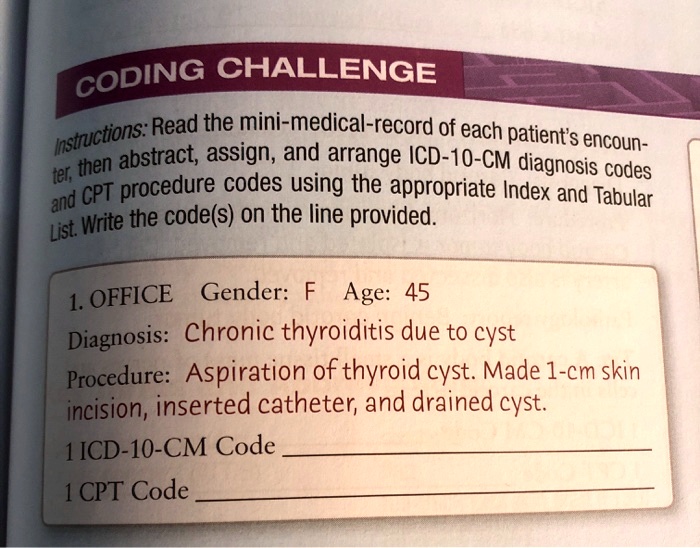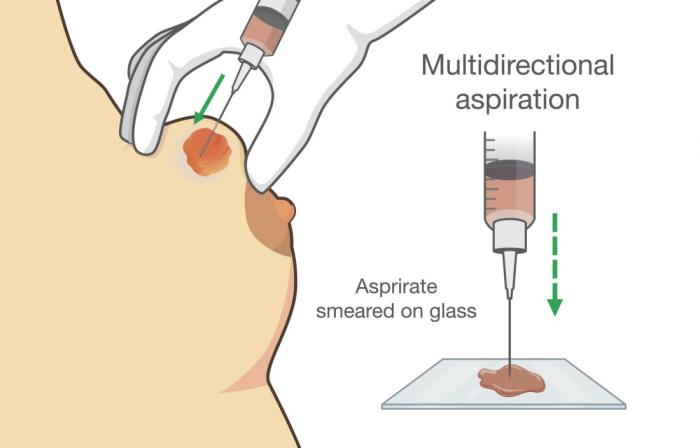Delving into the realm of CPT coding, we embark on a journey to decipher the intricacies of the CPT code for aspiration of cyst. This procedure, commonly employed in medical practice, demands our meticulous attention to ensure accurate documentation and billing practices.
As we navigate the complexities of aspiration of cyst, we will explore the specific CPT code assigned to this procedure, unravel its components, and delve into the indications and contraindications that guide its application. Moreover, we will meticulously Artikel the step-by-step procedure, ensuring a thorough understanding of its execution.
By examining the interpretation of aspiration results, we gain insights into the significance of cytology and histopathology in deciphering their implications.
Definition of Aspiration of Cyst
Aspiration of cyst is a minimally invasive medical procedure that involves removing fluid or other material from a cyst. It is commonly used to diagnose and treat various types of cysts, such as ovarian cysts, breast cysts, and ganglion cysts.
During the procedure, a thin needle is inserted into the cyst under ultrasound guidance. The fluid or other material is then withdrawn using a syringe. In some cases, a small amount of saline may be injected into the cyst to help visualize it during ultrasound imaging.
Instruments Used
The instruments used during aspiration of cyst include:
- Ultrasound machine
- Needle
- Syringe
- Saline (in some cases)
CPT Code for Aspiration of Cyst
Aspiration of a cyst is a procedure that involves using a needle to remove fluid from a cyst. This procedure is often performed to relieve pain, pressure, or other symptoms caused by the cyst. The specific CPT code assigned to aspiration of a cyst is 10060.
Components of the CPT Code
The CPT code 10060 consists of the following components:
- 10060:Aspiration of cyst
- 10061:Aspiration of multiple cysts
- 10062:Aspiration of cyst with injection of sclerosing agent
The first component, 10060, is the base code for aspiration of a single cyst. The second component, 10061, is used when multiple cysts are aspirated during the same session. The third component, 10062, is used when a sclerosing agent is injected into the cyst after aspiration to prevent it from refilling.
In the realm of medical coding, the CPT code for aspiration of cyst stands out as a specific procedure used to remove fluid from a cyst. However, sometimes, such procedures can trigger an outburst that may be symbolic of deeper emotional turmoil, as discussed in outburst that may be symbolic . Nonetheless, the CPT code for aspiration of cyst remains a valuable tool in managing cysts and addressing the underlying medical conditions associated with them.
Indications for Aspiration of Cyst
Aspiration of cyst, a minimally invasive procedure, finds its application in a variety of medical conditions characterized by the presence of cysts. These cysts can range from simple benign lesions to more complex ones with underlying pathologies.
The indications for aspiration of cyst can be broadly categorized into diagnostic and therapeutic purposes.
Diagnostic Indications
- Confirming the nature of a cyst:Aspiration allows for the withdrawal of fluid from the cyst, which can be analyzed to determine its composition, such as whether it is serous, hemorrhagic, or purulent.
- Distinguishing between different types of cysts:The characteristics of the aspirated fluid, including its color, viscosity, and cellular content, can help differentiate between various types of cysts, such as simple cysts, epidermoid cysts, and sebaceous cysts.
- Detecting underlying infections or malignancies:Aspiration can aid in identifying any underlying infections or malignant processes within the cyst, which may not be evident from external examination alone.
Therapeutic Indications
- Relieving symptoms:Aspiration can alleviate pain, pressure, or discomfort caused by the presence of a cyst.
- Preventing complications:In some cases, aspiration may be performed to prevent potential complications, such as rupture or infection of the cyst.
- Treating infected cysts:Aspiration can be used to drain infected cysts and deliver antibiotics directly into the cyst cavity, promoting healing and preventing the spread of infection.
Contraindications for Aspiration of Cyst

While aspiration of cysts is generally a safe procedure, there are certain situations where it may not be advisable. Absolute contraindications are conditions where the procedure should not be performed under any circumstances, while relative contraindications are situations where the risks and benefits should be carefully considered before proceeding.
Absolute Contraindications
- Active infection:Aspiration of an infected cyst can spread the infection to other parts of the body.
- Bleeding disorder:Aspiration of a cyst can cause bleeding in people with bleeding disorders.
- Cyst located near a major blood vessel or nerve:Aspiration of a cyst in these areas can damage the blood vessel or nerve.
Relative Contraindications, Cpt code for aspiration of cyst
- Cyst is too small:Aspiration of a cyst that is too small may not be effective and could cause unnecessary discomfort.
- Cyst is too deep:Aspiration of a cyst that is too deep may be difficult and could increase the risk of complications.
- Cyst is located in a sensitive area:Aspiration of a cyst in a sensitive area, such as the face or genitals, could cause discomfort or scarring.
It is important to discuss the potential risks and benefits of aspiration of a cyst with your doctor before making a decision about whether to proceed with the procedure.
Procedure for Aspiration of Cyst
Aspiration of a cyst is a minimally invasive procedure used to remove fluid from a cyst. It involves inserting a thin needle into the cyst and using suction to draw out the fluid.
The procedure is typically performed in a doctor’s office or outpatient clinic. It usually takes about 30 minutes to an hour, and most patients can go home the same day.
Patient Preparation
Before the procedure, the patient will be asked to:
- Fast for 8 hours before the procedure
- Avoid taking blood thinners for several days before the procedure
- Inform the doctor about any allergies or medical conditions
Anesthesia
The area around the cyst will be numbed with a local anesthetic. This will help to minimize discomfort during the procedure.
Procedure
The doctor will insert a thin needle into the cyst and use suction to draw out the fluid. The fluid will be sent to a laboratory for analysis.
Once the fluid has been removed, the doctor will apply a bandage to the area.
Post-Procedure Care
After the procedure, the patient will be monitored for any complications. The patient may experience some discomfort or bruising at the injection site. This should subside within a few days.
The doctor will give the patient specific instructions on how to care for the injection site and when to follow up.
Interpretation of Aspiration Results

The results of aspiration of a cyst can provide valuable information about the nature of the cyst and its contents. These results are typically interpreted by a pathologist, who examines the aspirated fluid under a microscope and may also perform additional tests, such as cytology or histopathology.
Types of Aspiration Results
The following are some of the different types of results that can be obtained from aspiration of a cyst:
- Clear fluid:This is the most common type of result, and it typically indicates that the cyst is benign (non-cancerous). Clear fluid may also contain some blood or other cells, which can be further analyzed to determine the nature of the cyst.
- Cloudy or bloody fluid:This type of result may indicate that the cyst is inflamed or infected. Cloudy fluid may also contain pus, which is a sign of infection.
- Thick or viscous fluid:This type of result may indicate that the cyst is filled with mucin, a thick, sticky substance. Mucinous cysts are often benign, but they can sometimes be cancerous.
- Solid material:If the aspiration needle encounters solid material, this may indicate that the cyst is a solid tumor. Solid tumors can be either benign or cancerous.
Significance of Cytology and Histopathology
Cytology and histopathology are two important tests that can be used to further interpret the results of aspiration of a cyst. Cytology involves examining the cells in the aspirated fluid under a microscope, while histopathology involves examining a tissue sample from the cyst under a microscope.
Cytology can help to determine if the cyst is benign or cancerous. Histopathology can provide more detailed information about the type of cyst and its prognosis. In some cases, a biopsy may be necessary to obtain a tissue sample for histopathology.
Documentation for Aspiration of Cyst: Cpt Code For Aspiration Of Cyst

Accurate documentation is essential for effective communication and patient care. When documenting aspiration of cyst, it is crucial to include relevant clinical information and procedure details.
Relevant Clinical Information
- Patient’s history and physical examination findings
- Reason for aspiration
- Location and size of the cyst
- Any previous aspirations or treatments
- Patient’s allergies and medications
Procedure Details
- Type of anesthesia used
- Aspiration technique (e.g., needle aspiration, surgical aspiration)
- Amount and character of fluid aspirated
- Any complications encountered
- Disposition of the aspirated fluid (e.g., sent for analysis, discarded)
By including this information in the documentation, healthcare providers can ensure accurate communication, facilitate patient follow-up, and support appropriate clinical decision-making.
Coding and Billing for Aspiration of Cyst

Coding and billing for aspiration of cyst involves assigning the appropriate CPT code and ensuring proper documentation to support the claim for reimbursement.
The CPT code for aspiration of cyst is 10004. This code includes the aspiration of fluid or tissue from a cyst, including the injection of a local anesthetic and the removal of the cyst wall if necessary.
Modifiers
Modifiers may be used to indicate specific circumstances or variations in the procedure. Commonly used modifiers for aspiration of cyst include:
- -50: Bilateral procedure
- -51: Multiple procedures
- -59: Distinct procedural service
Documentation Requirements
Proper documentation is crucial for accurate coding and billing. The medical record should include the following information:
- Patient’s history and physical examination findings
- Description of the cyst, including its location, size, and consistency
- Procedure details, including the type of anesthetic used, the amount of fluid aspirated, and any complications
- Post-procedure instructions and follow-up plan
By adhering to these coding and billing guidelines, healthcare providers can ensure appropriate reimbursement for aspiration of cyst procedures.
Q&A
What is the CPT code for aspiration of cyst?
The CPT code for aspiration of cyst is 10005.
What are the indications for aspiration of cyst?
Aspiration of cyst is indicated for the diagnosis and treatment of various medical conditions, including but not limited to:
- Cysts of the breast
- Cysts of the thyroid
- Cysts of the ovary
- Cysts of the kidney
What are the contraindications for aspiration of cyst?
Contraindications for aspiration of cyst include:
- Absolute contraindications:
- Infection at the aspiration site
- Bleeding disorders
- Relative contraindications:
- Large cysts (>5 cm in diameter)
- Cysts located near major blood vessels or nerves